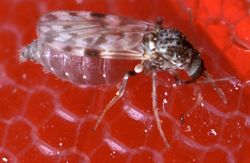Culicoides (genus)
| Literature database |
|---|
| 560 articles sorted by: |
| • year (descending) |
| • research topics |
| • countries/regions |
| • list of natural enemies |

Author(s): Scott Bauer, USDA Agricultural Research Service
Source: Wikimedia Commons
Culicoides Latreille, 1809
This genus of biting midges contains more than 1,000 species of very small hematophagous flies, measuring only 1-5 mm in size. Several species, e.g. Culicoides imicola, are important vectors of livestock virus diseases like the Bluetongue virus or the Schmallenberg virus. Males and females feed on nectar, but females also need a blood meal to produce eggs. They are "pool feeders" which means they injure the skin and then feed on the accumulating blood.
Breeding sites are usually muddy areas rich in organic matter, e.g. wet parts of cattle farms where mud mixes with cow manure. The larvae develop through 4 instars and the whole life cycle can be completed in about one month. For the identification of the species the wing pattern is often useful.
For a review of the genus see Purse et al. 2015.
Currently, the following species have been entered into the system: